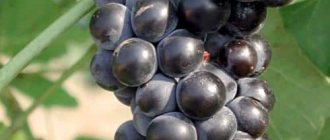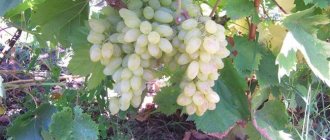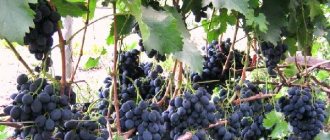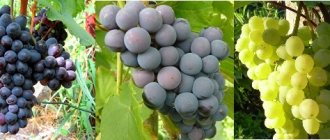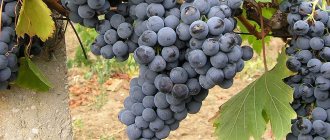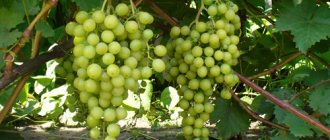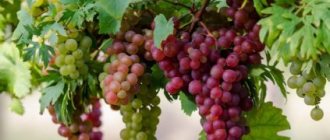Features of frost-resistant grape varieties
Grapes love warmth, light and sun. However, this does not prevent it from being grown in regions with a cold climate - in the Urals, Siberia, and some regions of the Far East. These lands are characterized as places with short and cool summers, sudden weather changes, frequent frosts and winds. Therefore, gardeners choose frost-resistant grape varieties for planting, which produce a stable harvest every year.
From an agrotechnical point of view, frost resistance is understood as the ability of a crop to withstand low temperatures without damaging the eyes of an annual shoot. These eyes are responsible for further fruiting and the number of healthy fruits. Agronomists divide frost resistance into several categories - weak, medium, increased. The colder the region, the higher it should be.
History of creation and features of selection
The breeding of frost-resistant grape varieties began under the leadership of I.V. Michurin. At the beginning of the 20th century, the first samples appeared that actually tolerated winter frosts and recurrent spring frosts. Russian Concord, Arctic, Buitur, Northern White, Metallic are varieties representing Michurin’s selection. Scientist-breeder Ya. I. Potapenko initiated the development of disease-resistant and first non-covering varieties: Suvorovets, Stepnyak, Medovy, Festivalny, Northern Saperavi.
Northern white
In the 60s of the 20th century, the promotion of viticulture to the north was continued in Orenburg by the famous breeder Shatilov. The most valuable frost-resistant hybrids were obtained by selecting wild vine species collected in the Urals and Siberia. This is reflected in the names of the varieties: Amur Early, Amur Black. The enormous work of breeders and enthusiasts has led to the fact that grapes in areas with harsh winters are now grown on an industrial scale. At the same time, its productivity is not inferior to southern plantations.
Today, zoned non-covering varieties have been created for the Urals, Far East, Primorye, and Non-Black Earth Region. Selection work is being carried out in the Smolensk region, Krasnoyarsk, and Altai. The progenitors of frost-resistant grapes are hybrids of European and American varieties with Amur wild species, which are not only adapted to wintering in frost conditions below -30°C, but also need them. They tolerate warm winters with frequent thaws much worse than severe cold.
AmurSha (Amur hybrid of Shatilov)
Uncovered forms of the crop are relevant when grown in open ground in the Middle Zone and Moscow region. Here, winter temperatures also regularly drop below -25°C. Climatic conditions over such a vast territory are very different, so non-covering hybrids in some areas require protection in winter, while covering hybrids can be cultivated without insulation in others.
Frost-resistant varieties differ from their southern counterparts in their ability to regenerate dead tissue. Non-fruiting buds are located in the ground and are activated when old roots die, replacing them with new ones. The vigorous growth characteristic of many hybrids makes it possible to replace dead parts of the plant in one season. New varieties form many ovaries, their number has to be regulated. The winter hardiness of the bushes suffers from being overloaded with fruits.
The sugar content of berries, which previously did not exceed 17%, has reached 24% in recent years in some new varieties. Northern fruits are somewhat smaller in size than southern ones, and their cluster weight is usually less. But selection work continues and there are more and more large table varieties.
Top best
How to choose a frost-resistant grape variety? To begin with, it is recommended to study the top best - their taste and commercial qualities, yield and features.
Isabel
The popular Isabella grape variety appeared in America and in a short time became widespread throughout the world. Gardeners are attracted by the appearance of the fruit - blue-violet berries with a dense white coating are beautifully collected in a large bunch. The weight of the brush reaches 2 kg.
Isabella's taste is rich, sweet and juicy, with a strawberry aroma. The skin is dense, the flesh is tender and pleasant. The ripening period is about 6 months from the date of appearance of the first buds. The plant is tall, so spacious areas are chosen for planting it.
Lady fingers
Mid-season variety with a ripening period of about 140 days. The bushes are vigorous, the leaves curl, the color is rich green. The clusters are large, cone-shaped, the weight of one reaches 400 g. The fruits are elongated, the skin is thin, the pulp is of medium density.
Depending on the subspecies of the variety, the color can be light green with a yellow tint or pinkish. Lady fingers are valued for their pleasant sweet and sour taste with a tart aftertaste. Productivity is about 4 kg per 1 sq. m.
Lydia
The technical grape variety Lydia is often confused with Isabella - both varieties originated in America and have several similarities. The bushes grow quickly and are powerful. Up to 40 kg of delicious grapes are harvested from one bush per season. The berries ripen gradually, the fruiting period is extended.
The shape of the fruit is round, the color is purple-red, and may be brown during ripeness. The skin is dense, so the crop is suitable for long-term storage. The pulp has a strong berry aroma, the taste is sweet and tart. Lydia grapes are used for fresh consumption or for preparing juices and compotes.
Sharov's riddle
The extra early variety ripens in 3-3.5 months. The bushes are small, the leaves are medium sized. The weight of the bunch is about 500 g, the shape is spreading. The berries are round, the weight of one varies from 2 to 3 g. The color is dark blue or black, there is a slight waxy coating.
The flesh is pleasant, there are small seeds inside. The taste is berry-fruity, the aroma is sweet. The fruits do not fall off after ripening and stay on the bushes for a long time. After harvesting, they are stored in a cool place for up to 80 days. Productivity is about 20 kg per plant per season. The variety is popular in Russia, Belarus and Ukraine.
Taiga
The name of the variety speaks for itself - Taiga is suitable for growing in the harsh conditions of the Siberian and Ural winters. The bushes are vigorous, the shoots are spreading. The clusters are conical in shape, weight - about 300 g.
The shape of the fruit is spherical, slightly elongated, the weight of the berry is 2-3 g. The color is dark purple or black, the peel is of medium density, with a slight light coating. The taste is sweet, without sourness. Taiga is universal in use - suitable for fresh consumption, processing, and long-term storage. Productivity is about 20 kg per bush.
Amur breakthrough
The height of the bush reaches 2.5 m, so Amur breakthrough is planted in spacious areas. The weight of the bunch is about 350 g, the berries are dark blue and round. The weight of one is 3 g, the thick skin protects the crop from cracking. Amur breakthrough is resistant to diseases, can withstand frosts down to -40°C, and is therefore suitable for cultivation in the coldest regions.
The taste is pleasant, sweet and sour, there are few seeds. It is important to monitor the level of moisture in the soil - the variety does not tolerate prolonged absence of watering. Productivity - 10 kg of fruits per plant.
Pink pearl
The variety received its name due to the beautiful red-pink spherical fruits. The berries are collected in a conical bunch weighing 400-500 g. The growing season is no more than 120 days. Berry weight - 5 g, medium-density pulp, tender. The taste is classic grape, pleasant. The skin is thin, so pink pearls are not suitable for long-term storage. Over the summer, gardeners harvest about 8 kg of ripe grapes from one bush. It is recommended to consume the berries fresh or process them immediately after harvest.
Tukay
The Russian variety Tukai is valued for its winter hardiness and ease of care. The clusters are large - up to 1.5 kg, ripen by mid-July. The berries are tasty and sweet, with a bright nutmeg aroma and high sugar content. The weight of one is 4 g, the skin is dense, the color is white-amber with green tints. The fruits do not fall off and are rarely attacked by insect pests and diseases. Productivity - up to 20 kg per bush.
Interesting! The above varieties are not only suitable for growing in harsh climatic conditions, but are also often used for cooking. The sweet and pleasant taste of grapes goes harmoniously with various products: pineapple, champignons, olives, chicken breast, cheese, herbs.
Features of planting roses
Since spring is late in Siberia, the soil often does not have time to warm up to a temperature comfortable for the roots, it is recommended to plant them on the south side of the site. To prevent the buds from burning out, it is advisable that the plants are in the shade during the hours of sun activity.
The climate of Siberia is characterized by cold northern and western winds. Therefore, the rose garden must have protection from these directions. These can be the walls of buildings, plants with a dense crown, gazebos or hedges. To prevent the wind barrier from greatly shading the roses, they are planted at some distance.
If possible, elevated areas are selected for the rose garden. In such places, the soil does not have time to freeze to critical temperatures and quickly thaws. This means that the roots will develop faster in the spring and are less at risk of rotting due to excessive moisture.
The planting season for roses in Siberia begins in May, when the soil warms up to 10 degrees
In Siberia, it is recommended to plant roses in the spring. The event is planned from May 15 to June 15. In this case, the air temperature should not be lower than +10°C. Shoots of plants planted later than this date do not have time to ripen, which causes death in the first winter season.
Otherwise, planting roses in Siberia differs little from warmer regions. In a pre-dug area for plants, a planting hole (50x50x50x) is formed and the substrate is prepared. To do this, mix the following components on a piece of film:
- humus 3 parts;
- peat 2 parts;
- weathered clay 1 part;
- river sand 1 part;
- wood ash 400 g.
The minerals superphosphate 300 g and potassium sulfate 30 g are added to the soil mixture.
The roots of the seedling, longer than 20 cm, are cut and immersed in a growth stimulator for 3-4 hours. The rose is planted with the grafting site deepened: for climbing roses by 10 cm, and for bush roses by 7 cm.
During planting, a hill is formed at the bottom of the hole, on which the seedling is placed and the roots are straightened. After powdering the roots and compacting the tree trunk circle, water with 10 liters of warm water. After this, the bush is hilled to a height of 10-15 cm, the soil under the bush is mulched with peat or humus. For the first time after planting, seedlings should be protected from direct sunlight.
The best early-ripening, mid-ripening, late-ripening grape varieties
Some gardeners do not like to wait long and prefer early varieties that produce the first harvest in early or mid-July. Others plant late-ripening grapes, which ripen only in the fall.
Early ripening frost-resistant grape varieties
Such varieties are chosen for cultivation in the northern regions. The ripening period varies from 95 to 110 days. During this time, the grapes have time to grow the vine, gain juiciness and sweetness. Also, early ripening varieties rarely get sick.
Muromets
The ripening period is 105 days, the bushes are vigorous, the weight of the bunch is about 500 g. The berries are dense and elastic, protected from cracking. The weight of the fruit is 4 g, the color is dark purple, there is a pronounced waxy coating on the peel. The pulp is dense and crispy, sweet. Muromets is distinguished by its keeping quality and ease of care. Productivity - 12 kg per plant.
Codrianca
The table variety is common in the northern regions and central Russia. The berries are large, round, dark purple. The weight of one is about 10 g, the weight of a bunch reaches 1.5 kg. The ripening period is 110 days. Kodrianka is valued for its sweet berry pulp and stable yield - gardeners harvest up to 20 kg per bush per season.
Hercules
Early table grapes ripen in 90 days. Clusters weighing up to 500 g, the berries are dense, light peach in color with a bloom. The taste is sugary and fragrant, with a nutmeg aftertaste. Hercules does not suffer from powdery mildew or rot, and is resistant to attacks by insect pests. Withstands temperatures down to -25°C. Suitable for fresh consumption, processing and storage. Productivity - 10-15 kg.
Mid-season varieties
Mid-season varieties are easy to care for. The grapes ripen by August, the berries grow large and juicy.
Original
The variety can withstand temperatures down to -22°C and is resistant to diseases. Medium-sized bushes with strong roots. The berries are pink-green, with a sharp tip. The peel is dense, the flesh is juicy and sweet. The original has a pleasant nutmeg aroma and a refreshing sweet and sour taste. The weight of the bunch is from 600 to 800 g.
Crisp
Vigorous grapes with large white-pink fruits. Berry weight - up to 3 g, bunch - 400 g. Delicate, berry aroma. The pulp is medium dense, sweet. Crispy ripens by the beginning of September. Productivity - up to 10 kg per plant. Universal in use.
Chocolate
The berries have an original chocolate-nutmeg taste. The shape is oval or cylindrical, the color is purple-brown, the skin is dense. The weight of the bunch varies from 700 to 1200 g, the weight of the berry is about 8 g. To experience the unusual taste of Chocolate grapes, it is recommended to consume them fresh.
Late ripening varieties
The average ripening period for late-ripening grapes varies from 150 to 170 days. The fruits are rarely affected by rot and are resistant to insect pests.
Taifi
The berries are large, white or pink, rounded-elongated in shape. The weight of the berry is about 4 g, the surface of the grape is covered with small dots and a waxy coating.
The pulp is juicy, fleshy, crispy. The taste is sweet with a slight sourness. Tayfi is valued for its attractive presentation and versatility in use.
Hercules
Withstands temperatures down to -23°C, unpretentious in cultivation. The weight of the bunch reaches 1 kg, the shape is conical. The weight of the berry is about 3 g, the taste is sweet and sour, the aroma is rich berry. The color of the peel is purple with a blue tint. Productivity - 8-12 kg per bush.
December
A purple grape variety with delicate pulp and small seeds. The weight of the bunch is about 300 g, the berries are compact and elastic. It is resistant to diseases. The taste is sweet, the yield is stable - about 13 kg per plant. They are grown in the middle zone, Tatarstan, Samara region, and Moscow region.
Attention! Experienced gardeners recommend covering late-ripening grape varieties with burlap for the winter. The fruits ripen late, so it would be a good idea to provide them with additional protection.
Popular uncovered varieties
A large and sweet fruit is the key to a winegrower’s success, but in cold winter conditions one should also take into account the species’ ability to tolerate frost. By planting uncovered grapes, you can avoid many problems and reduce the amount of work on the site. The main thing is to know the varieties that will best withstand frost.
Jupiter
If you want to grow uncovered wine grapes, then the best variety will be Jupiter, which can withstand frosts down to −27 °C. It is early dark, ripens in 3.5 months, and the berries in the bunches are up to 0.5 kg. The taste is pleasant, nutmeg, and has no seeds. Fleshy and sweet, pollinated well and pleases with a rich harvest.
Alpha
The uncovered grape variety Alpha belongs to the isabella species. Its brushes are not large, about 200 g. The bush is quite strong, develops well, and the vine forms early. The bush has large leaves, so it is perfect for a gazebo. The berries are round, dark blue, and become almost black when overripe.
Alpha
The ability to withstand extremely low temperatures down to −35 °C has been officially registered. Unpretentious, disease-resistant, highly attractive.
Important! Alpha produces delicious juice and wine.
Disadvantages include:
- susceptibility to chlorosis;
- a large number of stepchildren;
- love of birds;
- the need for regular watering;
- demands on soil;
- inability to tolerate transportation.
It is Alpha that does not tolerate drought at all; watering should be carried out regularly and in large quantities.
Platovsky
One of the most impressive grape varieties is the uncovered Platovsky, which tolerates frost well, is not susceptible to disease, has a bright taste, and the wine from it exceeds all expectations. The weight of the bunch is only 250 g, the color of the berries is greenish-yellow, and with a lot of sun it becomes orange-brown.
White, dark and pink varieties
White varieties are commercial and table varieties; these include berries of white, light yellow and green colors. The berries are used for processing and food, and they prepare juices, wines, and compotes. Russian gardeners choose the varieties Arcadia, Aligote, White Muscat, and Chardonnay. Their average ripening period is 130 days; care consists of traditional watering and fertilizing. The berries can withstand temperatures down to -20°C, but it is recommended to cover them with protective material for the winter.
Dark varieties are famous for their sweet and juicy taste, pleasant berry pulp. The color of dark varieties is black, blue, purple, burgundy, brown. Among the frost-resistant grapes, black Vostorg, Kodryanka, and Athos are noted. Dark grapes are rich in sugars and contain healthy vitamins and minerals.
Pink grape varieties are loved for their attractive appearance - the berries are light red, pinkish, with an amber tint. Popular varieties include Russian Early, Julian, and Tason. The berries are universal in use, and the plants are unpretentious in care. Both amateur gardeners and experienced farmers grow pink grapes.
Louise Swanson
Up to -35-40°C. A variety with a medium ripening period and moderate growth vigor. The clusters are small and dense. The berries are medium, green-white, round, with an average weight of 3 grams. Sugar accumulation up to 20%, with moderate acidity. Productive and stable variety. Compared to other hybrid varieties, the buds open relatively late, which reduces the risk of damage from late spring frosts. Sensitive to drought. Resistant to fungal diseases.
Best for different growing regions
For the coldest regions of Siberia, it is recommended to choose frost-resistant varieties that can withstand temperatures down to -40°C. These are the Amur breakthrough grapes, Lydia, Aleshenkin. With such varieties, gardeners can be sure that the shoots will not freeze and will delight you with juicy and large berries in the summer.
For milder frosts (up to -25°C), the grapes chosen are Lady's Fingers, Tukay, and Cardinal. For the winter, they are covered with thick burlap, and the protection is removed at the end of April or beginning of May. Such varieties are suitable for the Chelyabinsk, Sverdlovsk, and Orenburg regions.
In central Russia and the Moscow region, Isabella, Pink Pearl, and Taifi grapes are grown. As a rule, the lands here are more suitable for growing fruit crops. The grapes rarely get sick and are not a hassle to care for.
Kishmish Jupiter
Up to -29 °C - and tastier than Spartan, but not as frost-resistant. Similar to raisins Jupiter and Venus. Can be grown as an uncovered plant on arches, arbors, etc.
Down to -29°C, you need to be prepared for the fact that once every 6-7 years it will completely freeze to the level of snow. At the same time, next year Jupiter will quickly “beat off” new shoots from dormant buds and it will be possible to get a small harvest. We will test for lower temperatures if Mother Nature allows. Seedless variety, early ripening (115-125 days). The bushes are medium-sized. The clusters weigh 1 kg on average. The berries are large, weighing 4-5 grams, and color from red to blue-red when fully ripe. The pulp is fleshy and juicy, good taste with a slight nutmeg aroma. The skin is thin and durable. Sugar accumulation up to 21%. There may be freezing and death of the buds in frosty winters and spring frosts, fluctuating temperatures (plus during the day - below zero at night).
Up to -28°C and below, recommended for uncovered crops (arches, arbors, etc.). Brown (1977) variety, early ripening, 120 days). Bushes have above average growth vigor. The clusters are medium, from 200 g and above, cylindrical-conical, of medium density. The berries are small and medium 2-3 grams, round, blue. The pulp is fleshy and juicy, the taste is harmonious, with a light strawberry-nutmeg and blackcurrant aroma. The skin is not thick, separated by a “bag”. Seedlessness class I. Sugar content 18-20%, acidity 6-7%.
Down to -32°C, which makes it possible to grow it as a semi-covered or uncovered, seedless grape variety. Selection: USA. Late ripening (late September-early October), isabella type. The growth vigor of the bushes is medium to large. The flower is bisexual. The bunch is medium and large, wide, conical or almost cylindrical, with one, rarely two, wings, rather loose or dense. The berry is medium, round or oval, purple-red, dull, with a pronounced nutmeg. Sugar content 25%, acidity 8.8 g/l. The ripening of shoots is average. Productivity is average.
Up to -34°C, early ripening (115-125 days). Self-rooted bushes are vigorous. The clusters are medium-sized and large. The berries are round, yellow-green, with an average weight of 3-4 g. Seedless category I, rudiments are either absent or very small, practically not felt when eating. Increased resistance to fungal diseases and frost. Harmonious taste with strawberry flavor. Bunches 800-1200 g.
How to choose a frost-resistant grape variety
First of all, pay attention to the temperature regime. Each variety is designed for a specific temperature; it is recommended to obtain information about this from the seedling seller. For example, if the Original grape variety can withstand temperatures down to -22°C, then it makes no sense to plant it in Khabarovsk, where the temperature drops to -40°C - the bush will freeze.
Equally important are taste qualities and product characteristics - shape, color, weight. Some varieties are universal in application and are used for different purposes, others are intended only for food or processing. Berries with thick skins are used for storage; those with thin skins are eaten immediately after harvest.
Anniversary of Novocherkassk
This is one of the best technical grape varieties. It is ideally adapted for cultivation using the uncovered method in the middle climate zone, including in the Moscow region. The fruits of this variety are light pink, sometimes purple, and oval in shape.
Among the beneficial advantages that determine the high popularity among gardeners, we can highlight the following characteristics of the Novocherkassk Jubilee variety:
- The frost resistance threshold is minus 25 degrees.
- Ripening dates are early. Usually the harvest is harvested in early August and already from the second year of cultivation.
- The weight of the bunches is 1.5-3 kg.
- The sweet taste of juicy berries - according to the tasting assessment, the taste has an indicator of 8.6 points out of 10 possible.
- It pollinates independently due to the fact that this variety is bisexual.
- High yield - up to 20 kg of berries are harvested from one bush, every year.
Important! Resistance to diseases is very high, so it does not require too much scrupulousness in terms of caring for shrubs as they develop. Absolutely any soil is suitable for growing
